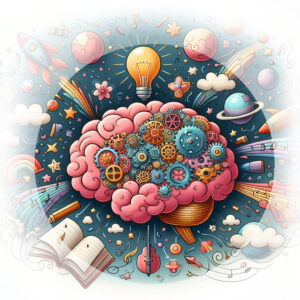
The Warnke
Therapy methods

Fred Warnke assumed that the majority of children with learning and speech disorders have deficits in the area of central auditory processing. Central means that it is not the hearing of the ears that fails, but the processing of acoustic stimuli by the brain. This applies to all stimulus processing processes in the brain, e.g. in the area of motor skills.
Central automation disorders are the cause of learning disorders with effects on the development of motor skills, language and social behavior

Symptoms that indicate a
perceptual disorder,
can be so different
as there are children.

This imperfect integration of language is now referred to by a wide variety of terms around the world, such as:
- Minimal cerebral dysfunction (MCD)
- Attention deficit disorder (AD) with or without
- Hyperactivity
- Partial performance disorders etc.
These children are often able to compensate well for their deficits and develop substitute strategies - but with a high expenditure of energy. Problems such as dyslexia and social exclusion often only become apparent in everyday school life.

The Warnke therapy method
always an examination to determine
central automation problems:

According to the concept developed by Fred Warnke, the following fourteen functions are tested in a playful process and compared with the norm data of children of the same age:

1. pitch differentiation

This ability is crucial for making sense of the language we hear and for making sense of our own speech. If this ability is not automated, many sentences can only be understood with a delay or incorrectly or spoken in a monotone.

2. eye - hand - coordination

This ability is an important prerequisite for writing. Hand-eye coordination that is not or only slightly automated inevitably leads to laborious writing.

3. directional differentiation

The ability to locate a sound source from a very specific direction is important in the unavoidable noise level of today's classes. Pupils should be able to concentrate on the teacher's voice without straining too much.

4. sound - differentiation

This ability is of fundamental importance for understanding language, because otherwise children have to "guess" what has been said. If this ability is not automated, the inevitable "guessing" of words that are not understood consumes an unnecessary amount of time and energy.

5. auditory order threshold

The ability to perceive two sensory stimuli in close succession in the auditory range separately and to "sort" them, i.e. to put them in order, is an essential prerequisite for the aforementioned sound differentiation. In children with good hearing from the age of ten, the sorting threshold is around 20 - 30 milliseconds. If this ability is not automated, the value is two to three times higher, which reduces linguistic competence enormously.
Remark: A prior examination of the peripheral hearing by a specialist is required.

The new
Support measures are based on three cornerstones:
1. automating the temporal processing
(order thresholds - training)

If the temporal processing of sensory stimuli in the brain is delayed, it makes no sense to practise reading and writing even more. It is much more effective to optimize the processing speed in the brain so that it runs automatically and without any particular effort. This is done with the help of the Brain - Boy - Universal, with which the children train a total of eight functions of central auditory processing and auditory perception.

2. automating the hemispheres - coordination
(Lateral - Synchron - Training)

Lateral synchronous training results in better networking and therefore faster, automated cooperation between the two hemispheres of the brain. The child's voice and the model voice from a CD are continuously fed to each other via headphones.
This is done with the Lateral Trainer, also developed by Fred Warnke. This support measure leads to an improvement in reading, writing and speaking.

3. automating the visual lexicon

An inadequate internal representation of the spelling of words is specifically corrected by "visual spelling". This teaches children of reading age a strategy that enables them to mentally store the exact fine structure of words as images,
which are not written aloud -
and that is more than 60 % of our linguistic heritage.
The individual daily training plan is discussed in a parent meeting (training device, "brainboy", is lent out for practicing). The training plan is explained to the child in order to achieve optimum training readiness. This method not only achieves significant improvements in the areas of language, reading and writing, but also has positive effects on the development of the child's overall personality and learning at school.